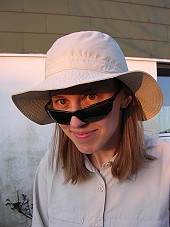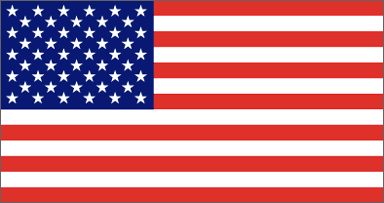
MARTINA'S WORLD TRIP
UNITED STATES: September 26 - December 3, 2004


(Übersetzungshilfe)
 |
MARTINA'S WORLD TRIP UNITED STATES: September 26 - December 3, 2004 |
|||||||
 |
||||||||
 |
Your Dictionary
(Übersetzungshilfe) |
|||||||
| Saturday, October 9th, 2004 - New Orleans, Louisiana | |||||||
| “La Nouvelle Orléans” was founded on the bend of the Mississippi River in 1718, after the state of Louisiana was claimed for French King Louis XIV in 1699. (It is the only state that once used to be a French royal colony.) New Orleans was ruled by France and then Spain for nearly 100 years. It is the only city in the United States where French was the predominant language for more than a century. Early immigrants arrived from France, Canada and Germany, and the French imported thousands of African slaves. Many Africans earned their freedom and had an established place in the community as “les gens de couleurs libres” (= free people of colour). Unsuccessful as a mercantile economy, the colony came to rely on barter, smuggling and local trade, and the city developed a reputation for extralegal activities. The 1791 slave revolt in the French colony of St. Dominique (now Haiti) caused thousands of former slaves to move to New Orleans. The French resumed control in 1803, but within days Napoleon sold the city to the US, along with the rest of the state in the Louisiana Purchase. Soon Anglo Americans developed slave-based plantations similar to those in Georgia and the Carolinas. By 1840, New Orleans was the nation’s fourth-largest city, with more than 100,000 people. During the American Civil War (1861-1865), New Orleans was the city occupied longest by enemy troops (the Union Army 1862-65). It survived the Civil War as the South’s largest city, while new federal laws required that voting and civil rights be extended to black males. White supremacists formed the White League, which ousted the government elected by newly enfranchised black voters, and introduced the Jim Crow laws that continued to impose racial segregation on blacks. The end of the plantation economy and the declining importance of river traffic hit New Orleans hard, and its economy languished until oil and petrochemical industries developed in the 1950s. Though now eclipsed by Atlanta as the South’s largest city, metropolitan New Orleans has over 1.3 million people, composed of a growing African-American population (62%), Anglo Americans (35%) and Latinos (3%). Despite the Civil Wars and the gains of the Civil Rights movement, many blacks remain impoverished, and the gap between wealthy whites and poor blacks seems as wide as ever. This is as much as I read about New Orleans (with the accentuation on the ‘O’, not on ‘eans’) before Aaron and I decided to spend a weekend in this historically colourful city, not far from Pensacola. After a three-hour drive, we arrived in New Orleans around 2:30 pm this afternoon and first checked in at St. Charles Guest House, a Bed & Breakfast place we had found on the internet (www.stcharlesguesthouse.com/index.html). After a short break, we took a historic trolley-car to the city centre. The New Orleans Streetcar line is the oldest continuously operating rail system in the world. It runs from uptown to the business district along St. Charles Avenue and along Canal Street. Canal Street reminded me of Blvd Anspach in Brussels and is supposedly the widest city street (measured from doorstep to doorstep) in the United States. This is where we got of the tram and started our walk to explore the French Quarter. Well known amongst Americans for its European flavour, New Orleans is famous for its blend of cultures clearly visible in architecture, food and music. The French Quarter is a living example of this distinct mixture, resulting in a unique atmosphere. The whole French Quarter is a National Historic District where everything is still authentic. Many of the buildings found here date back to the 1700s, and most of the architecture is Spanish, not French. The entire area consists of 120 blocks, nestled on the bend of the Mississippi River. The French Quarter is divided into a residential area in the lower Quarter, astounding the visitor with narrow streets and passageways, featuring elegant architectural remains of the 18th-century Spanish colony, and the upper Quarter with bright lights and noisy bars along Bourbon Street as well as fancy antique shops and trendy art galleries on Royal Street. Wherever you go, you are amazed by mainly well-restored, brightly coloured buildings, lacy ironwork balconies, and lush, hidden pocket gardens. I loved walking around, discovering new beautiful buildings around every corner. But the French Quarter does not only spoil your eyes, it also indulges your ears and nose: blues, zydeco (accordion-based ethnic music) and of course jazz are oozing out of every bar and aromas of African, Spanish, French, Italian and Caribbean culinary influence spill into the streets. We also spent quite some time on Bourbon Street which is definitely comparable to Hamburg’s Reeperbahn or any other crazy red light district - just maybe a little more insane and nuts than anything I have ever seen before... Add the subtropical heat and humid air (it was raining quite a bit today), and you may get a pretty good picture of what New Orleans is like. Later we went into a cosy bar on Bourbon Street where a small jazz band performed live. The place was called “Frizel’s” and had a clear bias to German (beer) culture! Afterwards we had dinner at a French-Italian restaurant and took a last stroll around. It was a fun day/evening and not even the rain could bother us much. Overall, we had a great sneak preview of what New Orleans has to offer, and when we finally returned to the guesthouse, I was tired but very happy. |
|||||||